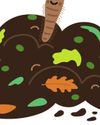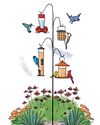يحاول ذهب - حر
Scratching Up A Storm
February - March 2017
|Birds & Bloom
Look down! That noise under your shrubs is a shy, ground-feeding towhee in search of its next meal.

When dry leaves rustle beneath your shrubs, you may think it’s a fidgety squirrel at first, but look closer. If you hear an odd, sharp call through the noise, a towhee may be responsible for the racket. Crouch down low and peer through the dense branches to catch a glimpse of this secretive visitor.
A little larger than their sparrow relatives, towhees spend a lot of time on the hunt for seeds and insects by scratching at dry leaf litter on the ground. You might assume that a bird stands on one foot and scratches with the other, but towhees have their own approach: They jump in the air and kick backward with both feet, sending dry leaves flying and exposing their favorite foods.
Anywhere in the eastern half of the U.S., scratching sounds that come from under dense thickets could reveal the presence of an eastern towhee. Males of this species are mostly black and white while females are mostly brown and white, but they both show a wide stripe of reddish brown, or rufous, along the side of the body.

هذه القصة من طبعة February - March 2017 من Birds & Bloom.
اشترك في Magzter GOLD للوصول إلى آلاف القصص المتميزة المنسقة، وأكثر من 9000 مجلة وصحيفة.
هل أنت مشترك بالفعل؟ تسجيل الدخول
المزيد من القصص من Birds & Bloom

Birds & Blooms
Better Off with Bats
Rethink the unsung heroes of the night and why you should support them
2 mins
October / November 2025

Birds & Blooms
Late Bloomers to Love
Keep garden colors going strong with fall perennials
3 mins
October / November 2025

Birds & Blooms
IN THE COMPANY OF OWLS
On any given morning, you'll find A.J. Berard trekking through the woods and mountains of Montana with a 45-pound pack and his Siberian huskies.
3 mins
October / November 2025

Birds & Blooms
Tree TLC
Discover tips for planting and tending to trees, from the roots up
2 mins
October / November 2025

Birds & Blooms
EASY. BREEZY Black-Eyed Susans
Planting rudbeckia, with petals aglow in honeyed yellow, fiery orange and velvety burgundy, is like sprinkling sunshine throughout the garden.
3 mins
October / November 2025

Birds & Blooms
Social and Adaptable
Find out how the house finch became a backyard regular
1 mins
October / November 2025

Birds & Blooms
Tales from the UNDERSTORY
The dense forest floor is the perfect setting to nest and forage
3 mins
October / November 2025
Birds & Blooms
Tracking Tiny Travelers
Small, numbered rings reveal the secrets of hummingbird migration
2 mins
June/July 2025

Birds & Blooms
The Dirt on Millicompost
Learn how to use millipedes to increase soil health
2 mins
June/July 2025

Birds & Blooms
THE PERFECT PAIRING
Learn the best ways to use an abundance of blooms to attract more birds and beautify your feeder space
3 mins
June/July 2025
Translate
Change font size

